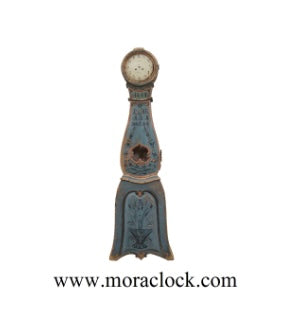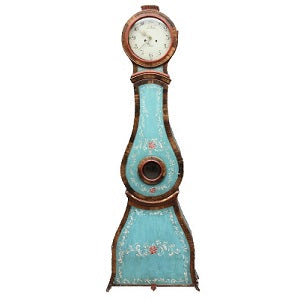
This article described the setting up of a Swedish Mora Clock
Many of the mechanisms of Mora Clocks are old but originally they would have worked.
The key to setting-up a Mora Clock so that it works is to discover whether the clock is damaged or simply needs a bit of work to set it up and start.
Before we begin:
It’s necessary to know a little about clock movements and names for some of the pieces as this makes the whole process easier. The mechanism of most long case clocks consist of 2 mechanisms that are separate but work together. Generally the clocks have 2 weights which attach to the pulley cord of two barrels. One of these, generally on the right facing the clock has the heaviest weight attached to it and is the driving mechanism for the hands of the clock to keep the time. This is driven by the pendulum. The other weight hands on the left facing pulley and is for the strike on the hour – ie drives the hammer to strike the bell (or in some clocks a metal coil).
The pendulum is to allow for adjustment to the speed of the hands of the clock – ie to regulate the time keeping. The pendulum hangs through the ‘fork’ as part of the ‘escapement mechanism’ which will move freely without the pendulum and is driven by the wheels of the clock and ultimately the right hand weight.
A diagram of various clock parts is:

The easiest way to find out if the Mora Clock mechanism is going to work is to attach the right hand weight to the pulley without suspending the pendulum. The fork of the escapement should move rapidly at the back of the clock. Sometimes this does not happen either because certain parts are damaged or (more likely) the point at which the barrels of the clock attach to the clock plate have become worn. Usually there is a copper ‘circle’ inside and where the clock has worn these then the barrels can ‘stick’ which limits the movement of the clock. This should be taken to a clocksmith to ‘rebush’ these copper circles.
If the fork moves rapidly then attach the left weight for the strike to determine if the strike work ok. Sometimes the strike can be hindered by a rotating ‘paddle’ at the top of the clock which may have become stuck by the bell. Typically in Mora Clocks the bells can be moved by pushing them away from this paddle so that it can then rotate freely.
Often the hammer can be bent so that it either dos not strike the bell or when it strikes there is a dull ‘thud’ This can be corrected by bending the arm of the strike appropriately.
Prior to setting up the clock
It’s best to fix the Mora Clock to wall and ideally a flat part of the wall – so avoid positioning the clock in a corner. This is to stop the being accidentally moved and also to stop the clock moving on its own accord when the weights hand in the center of the clock and then swings to the clocks pendulum swing. The pendulum would stop when this happens.
The best way to fix the clock to the wall is to first fix a pieces of wood to the wall of a thickness that will allow the clock to stand vertical. So if there is a skirting board then the thickness of the wood should be adjusted for the thickness of the skirting board. Then fix the clock with a screw through the inside of the clock to this pieces of wood on the wall. This position can be 2/3rd of the way up the body of the clock.
To set up the Mora Clock
Firstly attach the pendulum to the back of the clock. At the back of the mechanism towards the top is a suspension piece on which the top of the pendulum should hang:

The neck of the pendulum should then be positioned in the center of the fork – ie with the outside of the fork on the outside of the pendulum neck. The pendulum should hang freely ie it should not touch the back of the clock as this will impeded its movement. It is advisable to use a spirit level to check that the clock is vertically level.
Next steps is to test the swing of the pendulum.
Attach the larger weight to the right hand pulley:

Then attach the smaller weight to the left hand pulley
Regulate the pendulum
The pendulum should swing equi-distance from the left to the right. ie it should ‘tick’ at the same position on the left as the right. If there is an imbalance then the clock with run and eventually stop as it will go out of sync. When the pendulum is hanging at rest mark with a chalk piece the back of the clock when the pendulum hangs. Then hold the pendulum and move it to the right (or left) and mark on the back of the clock when the ‘tick’ is and repeat for the other side. Ideally the 2 outer white marks should be the same distance from the middle mark.
If it is too far the left then the whole clock should be tilted a little to the right (or vice versa) until the ‘tick’ is repositioned to the correct distance from the center mark.
The easiest way to do this is to place thin strips of wood below one side of the wooden runner board on which the mechanism sits and where it meets the wooden sides of the body of the clock. The difficulty with this is that only a limited about of movement can be gained and there is the possibility of the numbers on the face of the clock then be wrongly aligned.
The correct way is to carefully bend the crutch at the back of the clock. This requires care as the crutch can be damaged and it is safest to achieve the even ticks (ie when a clock is ‘in beat’) by bending the crutch several times. If the clock is too far to the right then the crutch should be bent to the left.
Once the clock is running smoothly then the hood of the clock can be placed on top of the clock body.
Make sure the arms of the clock face can rotate clockwise freely – if the arms ‘catch’ on the glass of the hood then this may cause resistance and slow the clock (ie do not push the hood on so that it restricts the clock face arms)
Most clocks run for 8 days and can be wound by turning the clock key inwards for both the right and left hand weights. However because these clocks tended not to be made by clocksmiths then the odd exception may exist and if resistance is met when winding such the key will not turn then try winding from the other direction.
Clock running slow
If the clock is running slow then the pendulum swing will need to speed up. This is done by moving the pendulum bob upwards. Hold the neck of the pendulum and gentle nudge the pendulum bob upwards. It is likely that this will need to be done several times before the clock keeps accurate time.
Clock running fast
The opposite should be done: the pendulum swing will need to be slowed down by nudging the pendulum bob downwards.
To ‘wind’ the clock the key is inserted in the right facing hole on the face of the clock. Wind the key to bring up the weight – the key will only wind in one direction. To ‘wind’ the weight for the strike this is the left facing ‘key’ hole on the face. It is easiest to do this with the hood removed as you will then be able to see the cog with the pully rope rotating.
If there are difficulties in setting up your Mora Clock then please call one of our staff members at www.moraclock.com
Source:
http://www.moraclock.com
More information on Swedish Mora Clocks
Contact Us for Further Details
Author: Richard Roberts
Date Published: 24 October 2017


